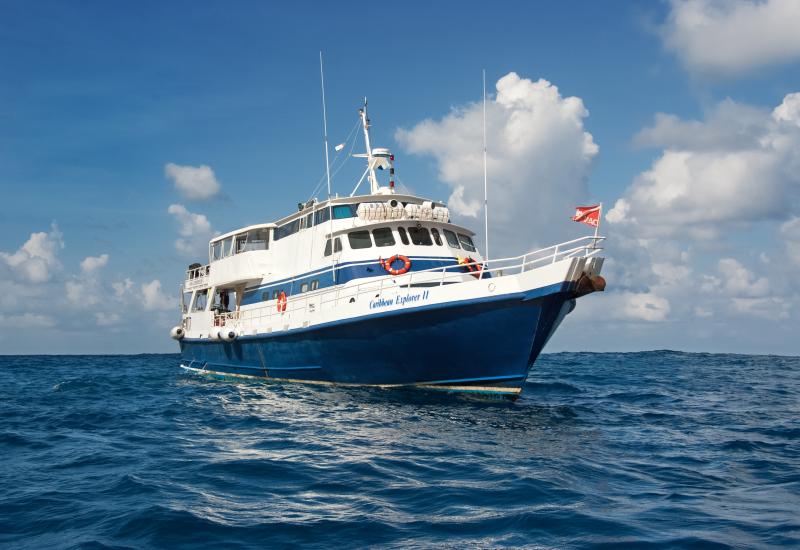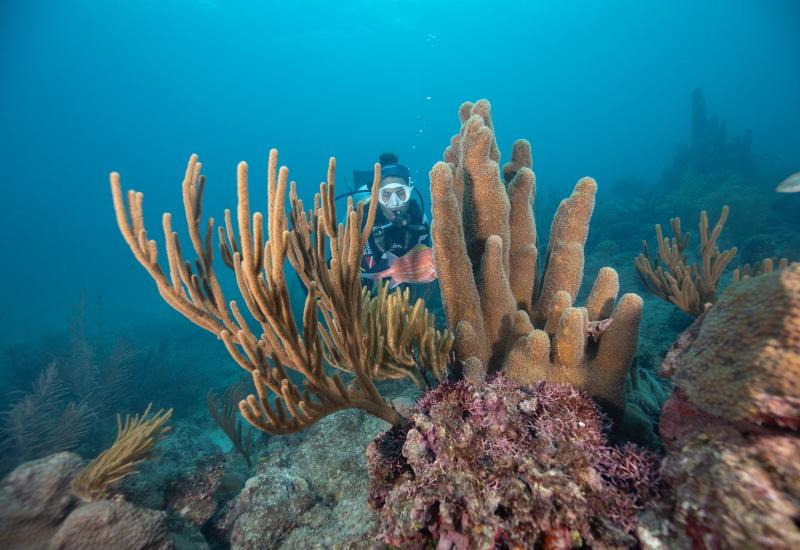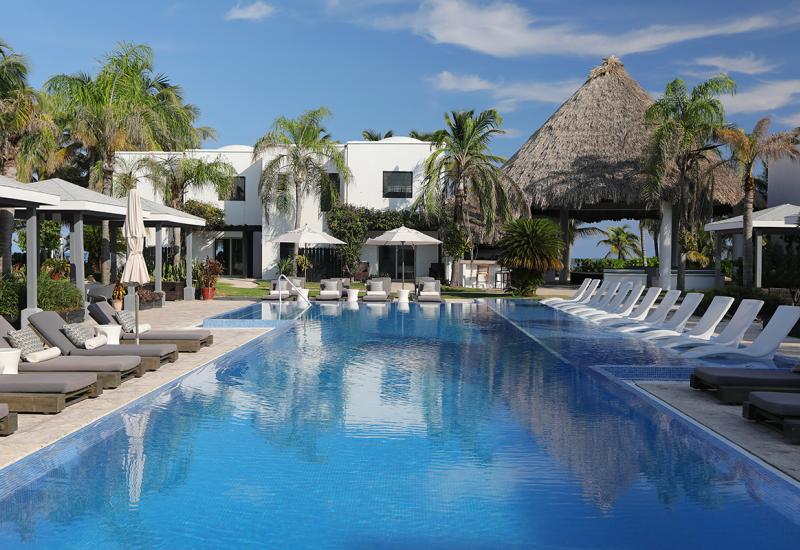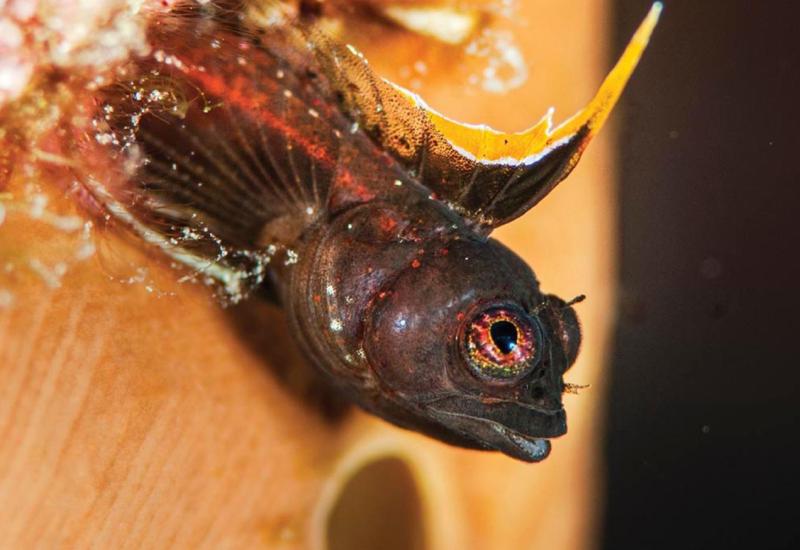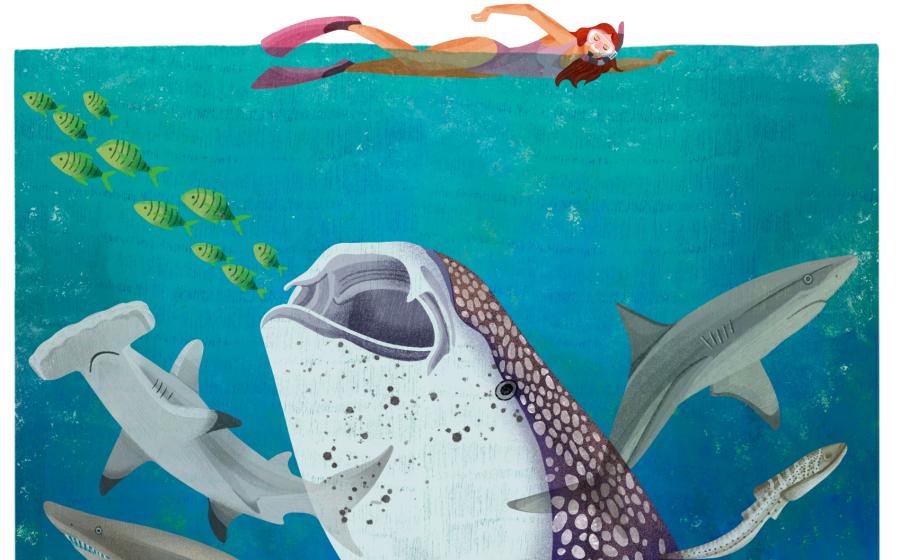Bahamas Travel Information
Customs/Entering
To protect the marine environment, spear fishing using scuba gear and possession of spear guns are illegal in the Bahamas. (Free diving with a Hawaiian sling is permitted.)
As part of the customs inspection, your luggage, including dive and photo gear, may be searched thoroughly upon entering the Bahamas. So use common sense when packing. Bahamian customs inspectors are friendly and courteous and they recognize the importance of tourism to their local economy. Those who cooperate by having their luggage ready for inspection will be on their way quickly and the procedure will go smoothly.
Customs/Departing
There is a $15 departure tax collected at the airport by the airlines. Please be ready for this and have exact change available. Credit cards and travelers checks are not accepted. If you present a large bill that requires change - be aware that you may receive Bahamian currency back. Exact change prevents this from happening.
U.S. residents are allowed to take home, duty free, items valued at up to $600 per traveler (over the age of 21) up to $1000 beyond the $600 exemption will be assessed at a flat rate of duty of 10% based on the fair retail value in the Bahamas. This limit includes 200 cigarettes or 100 cigars (not of Cuban origin), one liter of alcohol or two liters if one is the product of a Caribbean Basin Country.
Canadian residents who have been out of the country for seven days or more may bring home, duty free, goods valued at not more than $300 once each calendar year. This limit includes 200 cigarettes, 50 cigars, 2 pounds of tobacco (persons over the age of 16), up to 40 ounces of wine or liquor or 24 cans of beer.
U.K. residents may take home, duty free, two ounces of perfume, nine ounces of toilet water and other goods worth a total of L$32. In addition, persons at least 17 years old may bring one-half pound of tobacco or 200 cigarettes or 50 cigars, The importation of some goods is restricted.
Reminder: Many U.S. residents traveling to foreign countries are under the impression that articles purchased and worn or used (i.e. watches, clothing, cameras, etc.) while on the trip need not be declared. This is not true! All articles purchased abroad (or received as a gift) Must be reported on the customs declaration or the traveler may be subject to severe penalties. It is a violation of the law to make a false declaration, either written or orally.
Documentation
A valid passport is not required for entrance into the Bahamas BUT IS STRONGLY RECOMMENDED. An original birth certificate with a raised seal and a photo ID is required. Driver's License by itself is no longer accepted ID into the islands. Travelers will also be required to possess a return or onward ticket.
Minors: Children and infants each require separate tourist cards. In addition, the number of accompanying minors should be noted on the tourist card of the parents. Minors under the age of 18 years must travel with the consent of either parents or guardians. If a minor is traveling with only one parent, that parent should hold a notarized letter of consent from the absent legal parent or guardian or a copy of the legal document giving that parent sole custody.
Newlyweds: Tickets and documents must be in the same name. If not, the passenger should carry additional documentation explaining the name change. In the case of a newlywed, either a copy of the marriage license or a notarized affidavit (follow the above instructions) in the married name should be carried. {mospagebreak}
Immigration
When you travel to the Bahamas from a foreign country, you are given an immigration card to fill in. The Immigration Officer at the point of entry pulls the card and leaves you with the stub. Be sure to return this portion upon your departure.
ATMs
Visitors to Nassau and Paradise Island can get instant cash any time they need it. The ATMs operated by Royal Bank of Canada and the Bank of Nova Scotia provide 24 hours of convenient banking services.
For your convenience Royal Bank ATMs are located at the Tourist Information Booth, Rawson Square and the casinos on Cable Beach and Paradise Island. These machines accept VISA, MasterCard and any bankcard connected to the Plus or Cirrus network. A minimum of $50 must be withdrawn. Funds are given in United States currency.
ATMs at Royal Bank branches throughout the island and at two Esso Service Stations - Village and Wulff roads circle plus East Street and Soldier road - dispense Bahamian dollars.
The International ATM at the Bank of Nova Scotia downtown Bay street also dispenses U.S. dollars for American Express, Discover, MasterCard and VISA and any bank card connected to the Plus, Cirrus, Novus or Honor networks. Minimum withdrawal is $20.
Banking Hours
Banks are open from 9:30 a.m. to 3 p.m. Monday through Thursday and 9:30 a.m. to 5 p.m. on Friday.
Currency
If you should run across a Bahamian $3 bill, its okay. Bahamian paper money runs in half-dollar, $1, $3, $5, $10, $20, $50 and $100 bills.
There is an extra Bahamian coin as well, the 15 cent piece which is square with rounded corners and decorated with a hibiscus on the reverse.
Exchange Rates
The Bahamian dollar is on par with the U.S. dollar; however, one can expect to pay a small commission on exchange of traveler's checks for local currency and when converting local currency into U.S. dollars.
Baggage Charges
There is no charge for up to two pieces of hand baggage plus small bags and packages carried by the passenger. Each additional piece of luggage costs 30 cents.
On the islands of New Providence and Grand Bahama, government sets the maximum taxi fares and all taxis are required to have meters in good working condition.
General Rates: One or two passengers for the first one-quarter of a mile is $2. For each additional one quarter of a mile, 30 cents. For each additional passenger $2. There is no charge for accompanied children under three years of age.
Waiting Charge: The charge for having a taxi wait (except when hired by the hour) is 30 cents per minute
Long Distance Telephone Calls
Long-distance collect, AT&T; phone cards and credit card calls can be made from your hotel.
Note: Call COLLECT to avoid taxes.
Bugs
As is the case in all of the Tropics, insects could be a problem. Even though you will probably have no need for it, you should bring some insect repellent. As long as you are going to bring some, bring the best. Deep Woods Off or the strong Cutter's is recommended. In addition, Skin-So-Soft works really well for "No-See-Ums" (Sand Fleas). {mospagebreak}
History of the Bahamas
When thinking of the New World, it is quite usual for Christopher Columbus to be mentioned in history as the discoverer, though this is not true. When Columbus first landed in The Bahamas on the island of San Salvador on October 12, 1492, he met the Lucayan Indians, resident, it is believed, since around the ninth century AD. The Lucayans, by all accounts were a peaceful, graceful people who had left South America some five hundred years before. It is regrettable that the Lucayans were enslaved by the Spaniards and within another twenty-five years, were eradicated completely.
With the arrival of Columbus aboard his ship the Santa Maria, came the age of the conquistadors, who were more interested in gold, silver and other treasures than in the Lucayans and the natural beauty of the islands. Columbus set off again, landing on Long Island and Rum Cay on his way to Cuba and Hispanola. The Santa Maria was sunk and he left some of his crew on the islands. When he returned again in 1493, they were dead. Later, with the Lucayans enslaved and their islands pillaged, the Spanish turned their attention elsewhere, leaving the country passive and deserted for the next hundred years.
The next noticeable event of record was the arrival in the 16th century of the colorful Ponce de Leon, in search of the fabled ?fountain of Youth'. He explored several of the islands around 1513, landing on San Salvador. Other Spanish sea captains passed on their way to Spain during this period, but English settlement of the New World did not begin in earnest until the early 17th century. In 1629, Charles I granted rights on all land from the Carolinas to The Bahamas to his Attorney General, Sir Robert Heath. Nothing was to become of this, however. Charles lost his head in the political turmoil of the times and Heath fled to France in exile.
Religious intolerance in Europe caused others to flee too, colonizing lands as far flung as Bermuda and the New World. William Sayle, a Puritan former governor of Bermuda, gathered together a band of settlers some seventy strong, who became known as the "Eleutheran Adventurers". They came to The Bahamas seeking religious freedom and settled on the island today known as Eleuthera, the Greek word for freedom. Other English settlers followed and prospered. An agricultural economy developed. In England, Charles II, however, was granting rights in The Bahamas to others, amongst them Anthony Lord Ashley, probably the most powerful of the six appointed in 1670.
Trouble continued in the Bahamas however, due to the presence of proprietary lords and other unsavory characters such as infamous pirates. Among these were Captain Avery, Ann Bonny and Captain Teach, the notorious Blackbeard, who came ashore in Nassau for fresh water and to watch for rich cargo ships and enemy vessels alike. Times were good for pirates, given the opportunities provided by the War of the Spanish succession and the War of Jenkins Ear. Many Spanish galleons were sacked as they returned, gold-laden, to Spain. The remains of 'Blackbeard's Tower' can still be seen today at Nassau's East End. Spain of course retaliated - Nassau was burned to the ground four times in 25 years during this period, thus adding to troubles of the resident Lords.
Something had to be done, and in 1718, Woodes Rogers arrived to take over as Royal Governor of a colony now directly under the control of the British Crown. In an attempt to rid the islands of piracy and threat from the Spanish, this colorful ex-privateer first granted pardons to some of the pirates in order to defend against Spain. This, coupled with many swift public hangings for those not willing to abide by the law, brought respectability to Nassau and New Providence. Rogers then improved fortifications and formed an Assembly of Bahamians in 1729.
Woodes Rogers eventually departed however, and for the next forty years, the islands muddled along with a mixed economy of agriculture, piracy and privateering until came the open rebellion of the thirteen Colonies in the 1770s. The effect on the Bahamas was immediate and profound. In one of the first US naval actions ever, the Americans attacked in 1776 and again in 1778. The Americans and Bahamians were more friendly than otherwise, however. In 1782, the Spanish took advantage of British disarray in the north and attacked Nassau once more. It was loyalist American Andrew Deveaux who recaptured The Bahamas for England in 1783.
{mospagebreak}
History of the Bahamas Cont'd
Ironically, the British had already recovered the islands, exchanging Florida for the Bahamas under the Treaty of Versailles in the same year. The next ten years were important for American Loyalists. The Bahamian people of today are descendants of loyalists who fled the American Revolution. More are Southerners who came during and after the American Civil War. Other Bahamians are descended from Africans who were put ashore by English sea captains when Britain abolished slavery in 1834. During the 19th century, the colonial system was firmly in place throughout the Caribbean. The merchants and farmers of The Bahamas did their best to maintain the affluence, profiting occasionally form others misfortunes, such as the American Civil War. Between 1860 and 1865, the Bahamas benefited immensely, running blockades in the South. The close of the 19th century would herald other events, such as the First World War, Prohibition and the true beginning of tourism and the islands as a playground for the rich.
By the turn of the 20th century, and extraordinary mix of culture and folklore was standing shoulder to shoulder with the American rich, hungry for vacations in a warmer climate. The Bahamas benefited yet again from a regular stream of Americans. Put on the map by the American Civil War, the property boom in nearby Florida and the efforts of entrepreneurs such as Henry Flagler, The Bahamas was slowly but surely off to its start as a desirable destination. On the outbreak of World War One in 1914 however, Bahamians in their hundreds left the country to fight in Europe. Post-war depression came, and with it, another hand of good fortune - Prohibition. Soon, Nassau was a great open liquor market, with cases by the thousands freely changing hands on their way to ?Rum Row' off the Jersey coast.
Many Bahamians became rich during the Prohibition. The Bahamas once again was becoming the pirate paradise of Woodes Rogers's time. Liquor and gambling attracted funds, in turn used to build new hotels and clubs. The rich wintered in this paradise and despite the efforts of the US Customs, the money continued to flow. When the end came in 1933, the Bahamas once again emptied and the country's unemployed rose steadily once again. Even greater events followed - the outbreak of war in `1939.
It was at this time that The Bahamas had a distinguished visitor--The Duke and Duchess of Windsor. The Duke, having abdicated the English throne to the horror and shock of much of Europe, came to the islands and brought with him his wife and a huge torrent of publicity. The Bahamas was once again in the limelight. During the war, the British and American High Command chose a New Providence site to build a huge pilot training base. Riots ensued over wages for construction workers on the project and Bay Street, largely dominated by entrenched white power, was sacked and burned. The airbase was eventually built and modernized after the war to become Nassau International Airport.
In the aftermath of World War Two, many pondered about what to do with the nation's sluggish economy. It was the controversial Sir Stafford Sands who began to shape The Bahamas' post-war direction. Sir Stafford and his colleagues established a Development Board to market the islands as a desirable holiday destination. With jet air services and a newly dredged Nassau Harbour to accommodate the largest ships, The Bahamas started to see the rewards of tourism. Similarly, a tax haven was established which today embraces the country's huge offshore financial industry. On July 10, 1973, after nearly 250 years as a colony, The Bahamas became and independent nation.
Customs/Entering
To protect the marine environment, spear fishing using scuba gear and possession of spear guns are illegal in the Bahamas. (Free diving with a Hawaiian sling is permitted.)
As part of the customs inspection, your luggage, including dive and photo gear, may be searched thoroughly upon entering the Bahamas. So use common sense when packing. Bahamian customs inspectors are friendly and courteous and they recognize the importance of tourism to their local economy. Those who cooperate by having their luggage ready for inspection will be on their way quickly and the procedure will go smoothly.
Customs/Departing
There is a $15 departure tax collected at the airport by the airlines. Please be ready for this and have exact change available. Credit cards and travelers checks are not accepted. If you present a large bill that requires change - be aware that you may receive Bahamian currency back. Exact change prevents this from happening.
U.S. residents are allowed to take home, duty free, items valued at up to $600 per traveler (over the age of 21) up to $1000 beyond the $600 exemption will be assessed at a flat rate of duty of 10% based on the fair retail value in the Bahamas. This limit includes 200 cigarettes or 100 cigars (not of Cuban origin), one liter of alcohol or two liters if one is the product of a Caribbean Basin Country.
Canadian residents who have been out of the country for seven days or more may bring home, duty free, goods valued at not more than $300 once each calendar year. This limit includes 200 cigarettes, 50 cigars, 2 pounds of tobacco (persons over the age of 16), up to 40 ounces of wine or liquor or 24 cans of beer.
U.K. residents may take home, duty free, two ounces of perfume, nine ounces of toilet water and other goods worth a total of L$32. In addition, persons at least 17 years old may bring one-half pound of tobacco or 200 cigarettes or 50 cigars, The importation of some goods is restricted.
Reminder: Many U.S. residents traveling to foreign countries are under the impression that articles purchased and worn or used (i.e. watches, clothing, cameras, etc.) while on the trip need not be declared. This is not true! All articles purchased abroad (or received as a gift) Must be reported on the customs declaration or the traveler may be subject to severe penalties. It is a violation of the law to make a false declaration, either written or orally.
Documentation
A valid passport is not required for entrance into the Bahamas BUT IS STRONGLY RECOMMENDED. An original birth certificate with a raised seal and a photo ID is required. Driver's License by itself is no longer accepted ID into the islands. Travelers will also be required to possess a return or onward ticket.
Minors: Children and infants each require separate tourist cards. In addition, the number of accompanying minors should be noted on the tourist card of the parents. Minors under the age of 18 years must travel with the consent of either parents or guardians. If a minor is traveling with only one parent, that parent should hold a notarized letter of consent from the absent legal parent or guardian or a copy of the legal document giving that parent sole custody.
Newlyweds: Tickets and documents must be in the same name. If not, the passenger should carry additional documentation explaining the name change. In the case of a newlywed, either a copy of the marriage license or a notarized affidavit (follow the above instructions) in the married name should be carried. {mospagebreak}
Immigration
When you travel to the Bahamas from a foreign country, you are given an immigration card to fill in. The Immigration Officer at the point of entry pulls the card and leaves you with the stub. Be sure to return this portion upon your departure.
ATMs
Visitors to Nassau and Paradise Island can get instant cash any time they need it. The ATMs operated by Royal Bank of Canada and the Bank of Nova Scotia provide 24 hours of convenient banking services.
For your convenience Royal Bank ATMs are located at the Tourist Information Booth, Rawson Square and the casinos on Cable Beach and Paradise Island. These machines accept VISA, MasterCard and any bankcard connected to the Plus or Cirrus network. A minimum of $50 must be withdrawn. Funds are given in United States currency.
ATMs at Royal Bank branches throughout the island and at two Esso Service Stations - Village and Wulff roads circle plus East Street and Soldier road - dispense Bahamian dollars.
The International ATM at the Bank of Nova Scotia downtown Bay street also dispenses U.S. dollars for American Express, Discover, MasterCard and VISA and any bank card connected to the Plus, Cirrus, Novus or Honor networks. Minimum withdrawal is $20.
Banking Hours
Banks are open from 9:30 a.m. to 3 p.m. Monday through Thursday and 9:30 a.m. to 5 p.m. on Friday.
Currency
If you should run across a Bahamian $3 bill, its okay. Bahamian paper money runs in half-dollar, $1, $3, $5, $10, $20, $50 and $100 bills.
There is an extra Bahamian coin as well, the 15 cent piece which is square with rounded corners and decorated with a hibiscus on the reverse.
Exchange Rates
The Bahamian dollar is on par with the U.S. dollar; however, one can expect to pay a small commission on exchange of traveler's checks for local currency and when converting local currency into U.S. dollars.
Baggage Charges
There is no charge for up to two pieces of hand baggage plus small bags and packages carried by the passenger. Each additional piece of luggage costs 30 cents.
On the islands of New Providence and Grand Bahama, government sets the maximum taxi fares and all taxis are required to have meters in good working condition.
General Rates: One or two passengers for the first one-quarter of a mile is $2. For each additional one quarter of a mile, 30 cents. For each additional passenger $2. There is no charge for accompanied children under three years of age.
Waiting Charge: The charge for having a taxi wait (except when hired by the hour) is 30 cents per minute
Long Distance Telephone Calls
Long-distance collect, AT&T; phone cards and credit card calls can be made from your hotel.
Note: Call COLLECT to avoid taxes.
Bugs
As is the case in all of the Tropics, insects could be a problem. Even though you will probably have no need for it, you should bring some insect repellent. As long as you are going to bring some, bring the best. Deep Woods Off or the strong Cutter's is recommended. In addition, Skin-So-Soft works really well for "No-See-Ums" (Sand Fleas). {mospagebreak}
History of the Bahamas
When thinking of the New World, it is quite usual for Christopher Columbus to be mentioned in history as the discoverer, though this is not true. When Columbus first landed in The Bahamas on the island of San Salvador on October 12, 1492, he met the Lucayan Indians, resident, it is believed, since around the ninth century AD. The Lucayans, by all accounts were a peaceful, graceful people who had left South America some five hundred years before. It is regrettable that the Lucayans were enslaved by the Spaniards and within another twenty-five years, were eradicated completely.
With the arrival of Columbus aboard his ship the Santa Maria, came the age of the conquistadors, who were more interested in gold, silver and other treasures than in the Lucayans and the natural beauty of the islands. Columbus set off again, landing on Long Island and Rum Cay on his way to Cuba and Hispanola. The Santa Maria was sunk and he left some of his crew on the islands. When he returned again in 1493, they were dead. Later, with the Lucayans enslaved and their islands pillaged, the Spanish turned their attention elsewhere, leaving the country passive and deserted for the next hundred years.
The next noticeable event of record was the arrival in the 16th century of the colorful Ponce de Leon, in search of the fabled ?fountain of Youth'. He explored several of the islands around 1513, landing on San Salvador. Other Spanish sea captains passed on their way to Spain during this period, but English settlement of the New World did not begin in earnest until the early 17th century. In 1629, Charles I granted rights on all land from the Carolinas to The Bahamas to his Attorney General, Sir Robert Heath. Nothing was to become of this, however. Charles lost his head in the political turmoil of the times and Heath fled to France in exile.
Religious intolerance in Europe caused others to flee too, colonizing lands as far flung as Bermuda and the New World. William Sayle, a Puritan former governor of Bermuda, gathered together a band of settlers some seventy strong, who became known as the "Eleutheran Adventurers". They came to The Bahamas seeking religious freedom and settled on the island today known as Eleuthera, the Greek word for freedom. Other English settlers followed and prospered. An agricultural economy developed. In England, Charles II, however, was granting rights in The Bahamas to others, amongst them Anthony Lord Ashley, probably the most powerful of the six appointed in 1670.
Trouble continued in the Bahamas however, due to the presence of proprietary lords and other unsavory characters such as infamous pirates. Among these were Captain Avery, Ann Bonny and Captain Teach, the notorious Blackbeard, who came ashore in Nassau for fresh water and to watch for rich cargo ships and enemy vessels alike. Times were good for pirates, given the opportunities provided by the War of the Spanish succession and the War of Jenkins Ear. Many Spanish galleons were sacked as they returned, gold-laden, to Spain. The remains of 'Blackbeard's Tower' can still be seen today at Nassau's East End. Spain of course retaliated - Nassau was burned to the ground four times in 25 years during this period, thus adding to troubles of the resident Lords.
Something had to be done, and in 1718, Woodes Rogers arrived to take over as Royal Governor of a colony now directly under the control of the British Crown. In an attempt to rid the islands of piracy and threat from the Spanish, this colorful ex-privateer first granted pardons to some of the pirates in order to defend against Spain. This, coupled with many swift public hangings for those not willing to abide by the law, brought respectability to Nassau and New Providence. Rogers then improved fortifications and formed an Assembly of Bahamians in 1729.
Woodes Rogers eventually departed however, and for the next forty years, the islands muddled along with a mixed economy of agriculture, piracy and privateering until came the open rebellion of the thirteen Colonies in the 1770s. The effect on the Bahamas was immediate and profound. In one of the first US naval actions ever, the Americans attacked in 1776 and again in 1778. The Americans and Bahamians were more friendly than otherwise, however. In 1782, the Spanish took advantage of British disarray in the north and attacked Nassau once more. It was loyalist American Andrew Deveaux who recaptured The Bahamas for England in 1783.
{mospagebreak}
History of the Bahamas Cont'd
Ironically, the British had already recovered the islands, exchanging Florida for the Bahamas under the Treaty of Versailles in the same year. The next ten years were important for American Loyalists. The Bahamian people of today are descendants of loyalists who fled the American Revolution. More are Southerners who came during and after the American Civil War. Other Bahamians are descended from Africans who were put ashore by English sea captains when Britain abolished slavery in 1834. During the 19th century, the colonial system was firmly in place throughout the Caribbean. The merchants and farmers of The Bahamas did their best to maintain the affluence, profiting occasionally form others misfortunes, such as the American Civil War. Between 1860 and 1865, the Bahamas benefited immensely, running blockades in the South. The close of the 19th century would herald other events, such as the First World War, Prohibition and the true beginning of tourism and the islands as a playground for the rich.
By the turn of the 20th century, and extraordinary mix of culture and folklore was standing shoulder to shoulder with the American rich, hungry for vacations in a warmer climate. The Bahamas benefited yet again from a regular stream of Americans. Put on the map by the American Civil War, the property boom in nearby Florida and the efforts of entrepreneurs such as Henry Flagler, The Bahamas was slowly but surely off to its start as a desirable destination. On the outbreak of World War One in 1914 however, Bahamians in their hundreds left the country to fight in Europe. Post-war depression came, and with it, another hand of good fortune - Prohibition. Soon, Nassau was a great open liquor market, with cases by the thousands freely changing hands on their way to ?Rum Row' off the Jersey coast.
Many Bahamians became rich during the Prohibition. The Bahamas once again was becoming the pirate paradise of Woodes Rogers's time. Liquor and gambling attracted funds, in turn used to build new hotels and clubs. The rich wintered in this paradise and despite the efforts of the US Customs, the money continued to flow. When the end came in 1933, the Bahamas once again emptied and the country's unemployed rose steadily once again. Even greater events followed - the outbreak of war in `1939.
It was at this time that The Bahamas had a distinguished visitor--The Duke and Duchess of Windsor. The Duke, having abdicated the English throne to the horror and shock of much of Europe, came to the islands and brought with him his wife and a huge torrent of publicity. The Bahamas was once again in the limelight. During the war, the British and American High Command chose a New Providence site to build a huge pilot training base. Riots ensued over wages for construction workers on the project and Bay Street, largely dominated by entrenched white power, was sacked and burned. The airbase was eventually built and modernized after the war to become Nassau International Airport.
In the aftermath of World War Two, many pondered about what to do with the nation's sluggish economy. It was the controversial Sir Stafford Sands who began to shape The Bahamas' post-war direction. Sir Stafford and his colleagues established a Development Board to market the islands as a desirable holiday destination. With jet air services and a newly dredged Nassau Harbour to accommodate the largest ships, The Bahamas started to see the rewards of tourism. Similarly, a tax haven was established which today embraces the country's huge offshore financial industry. On July 10, 1973, after nearly 250 years as a colony, The Bahamas became and independent nation.

